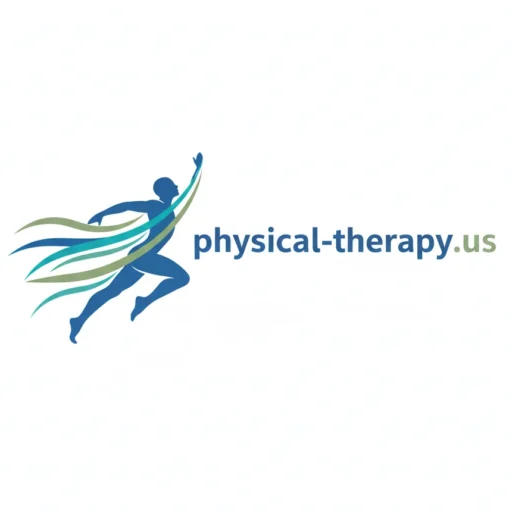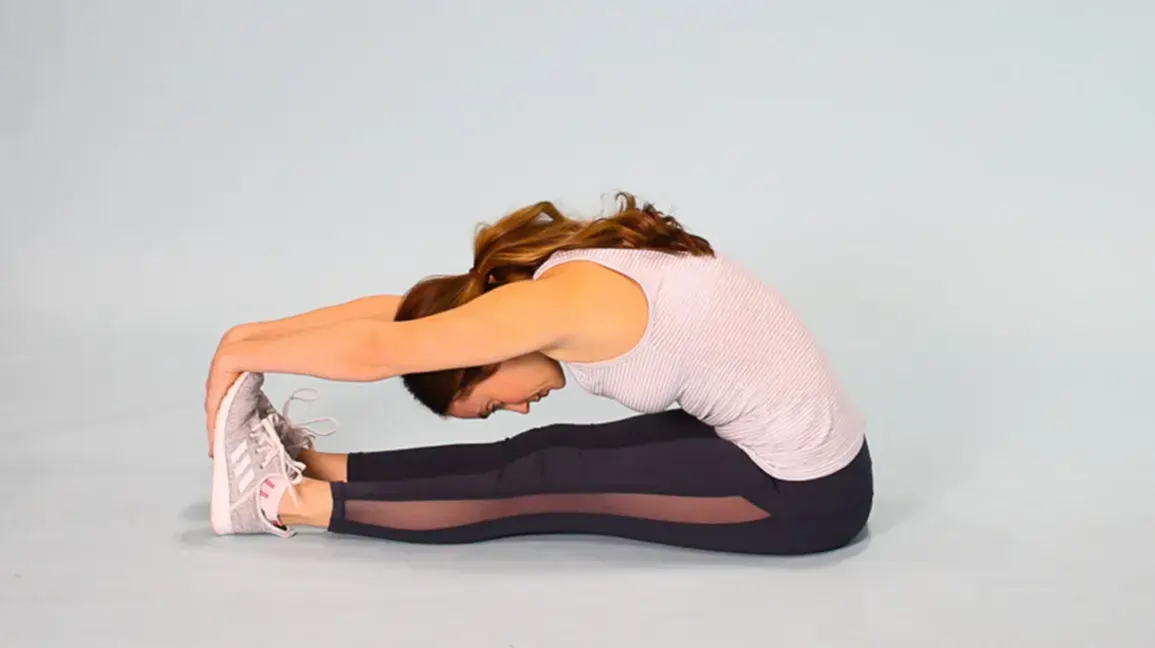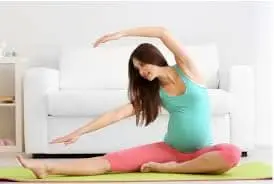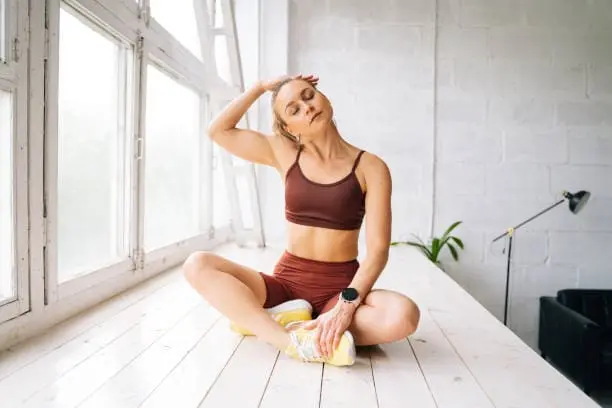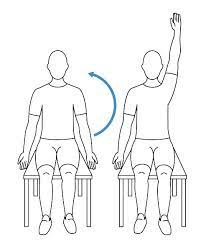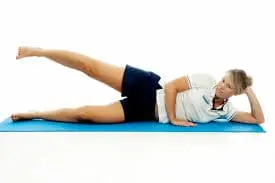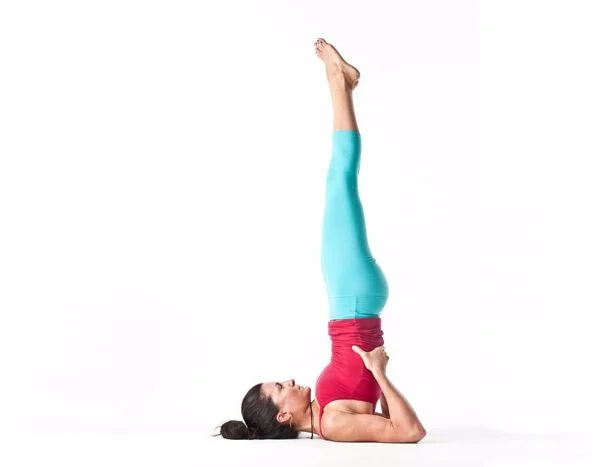19 Best Stretching Exercises Before Sleep
Stretching before sleep can help relax your body, reduce muscle tension, and promote better sleep quality. Gentle stretches ease stress, improve flexibility, and signal your body that it’s time to wind down. Incorporating a few minutes of mindful stretching into your nighttime routine can lead to a more restful and restorative sleep.
Introduction:
Stretching before bed is a quick and easy method to alleviate tense muscles, lower stress levels, and improve the quality of your sleep. Gently stretching can help you feel more relaxed, relieve aches and pains, and get your body ready for a good night’s sleep.
The end of the day is one of the ideal times to increase your flexibility because your body has been moving for a long time. In addition to improving your flexibility, performing a simple stretching exercise right before bed will help you relieve stress and clear your head, which will help you fall asleep deeply. Stretching should be moderate and mild, though, as a strenuous workout right before bed may stimulate you and make it difficult to fall asleep.
Stretching at night is best done whenever and whenever you will be doing it regularly. Aim for 30 to 60 minutes of stretching before bed. The goal is to gradually, not overly, expand the muscle groups, as is the case with all stretching. “When stretching, the most important thing to remember is not to overextend oneself. There shouldn’t be any pain. Breathing should be possible for you during the entire stretch.
Benefits of stretching:
A straightforward yet effective technique to relieve tension, promote better sleep, and relax your body is to stretch before bed. The way you feel before bed and how rested you are when you wake up can be greatly improved by adding a few easy stretches to your nightly routine.
Stretching before bed has the following main advantages:
Reduces Stiffness and Tension in the Muscles
Your muscles may feel strained and tight after a long day of standing, sitting, or moving about. Stretching is beneficial.
- Relax tense muscles.
- Lessen pain from exercises or regular tasks.
- Avoid cramping in your muscles as you sleep.
Improves the Quality of Sleep
You can get deeper sleep and fall asleep more quickly by stretching before bed.
- Reducing stress that can keep you up
- Lowering nighttime restlessness
- Encouraging relaxation and peace
Promotes relaxation and lessens stress
Stretching promotes attention and deep breathing, which:
- Relaxes the nervous system.
- Helps in your body’s sleep-mode transition.
- Lowers levels of the stress hormone cortisol
You can further improve your relaxation by combining stretching with deep, calm breathing.
Lowers the Chance of Injuries
Frequent stretching increases mobility and flexibility, strengthening muscles and joints. This can:
- Lower the chance of sprains and strains
- Improve alignment and posture
- Increase joint mobility for prolonged well-being
Increases Flexibility Over Time
Regular stretching increases joint mobility and muscle flexibility. This results in:
- Increased range of motion
- Reduced muscle stiffness and tightness
- Greater mobility in day-to-day activities
Improves Blood Flow
Blood flow to muscles is increased by stretching, which:
- Helps in the nightly recovery and regeneration of muscles
- Minimizes soreness and edema
- promotes cardiovascular health in general.
Legs Up the Wall and other similar stretches can improve circulation and lessen foot and leg edema.
Helps in the Relief of Joint and Back Pain
Back, shoulder, hip, and knee pain might be lessened by stretching before bed. Specific stretches:
- Reduce the strain on the spine
- Lessen joint stiffness
- Encourage blood flow to aching muscles.
Particularly beneficial are gentle poses like the Child’s Pose, Cat-Cow Stretch, and Seated Forward Fold.
Encourages Improved Posture
Back, shoulder, and neck pain can result from bad posture. Before going to bed, stretching helps by:
- Releasing shoulder and neck tightness
- Building up the muscles that help maintain proper posture
- Lowering the stress caused by slumping all-day
Stretching Exercises Before Sleep:
Side to Side Neck Stretch
Ideal for relaxing before bed, the Side-to-Side Neck Stretch is a quick and easy method to relieve stress in the upper back, shoulders, and neck.
- Sit with your shoulders relaxed and your back straight.
- As you gradually bend your head to the right and move your ear toward your shoulder, take a deep breath and release it.
- Feel a stretch along the left side of your neck as you hold for a few seconds.
- With your head tilted toward your left shoulder, repeat on the left side after returning to the middle.
- Then return to your neutral position.
- Then relax.
- Repeat these exercises 5 to 10 times.
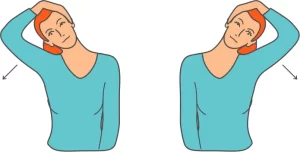
Low lunge
A great stretch for releasing tension in the hips, thighs, and lower back, the Low Lunge is ideal for relaxing before bed.
- Begin by kneeling on a soft surface, such as a bed or yoga mat.
- Maintaining your knee exactly above your ankle, take a step forward with your right foot to form a lunge.
- With the top of your foot and knee resting on the floor, extend your left leg back.
- For a deeper stretch, place your hands on your hips or front thighs, or lift them above your head.
- Maintain a tall spine and raised chest while slightly using your core.
- Hold this position for a few seconds.
- Then return to your neutral position.
- Then relax.
- Repeat these exercises 5 to 10 times.
- Switch sides and repeat exercises.
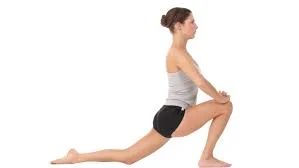
Overhead Stretch
The Overhead Stretch is a quick and easy technique to relieve stress in the spine, shoulders, and upper back. It’s excellent for encouraging calmness before bedtime.
- Your back should be straight while you stand comfortably.
- Take a deep breath and lift both arms over your head, palms up or fingers interlocked.
- Maintain a relaxed shoulder position as you extend your spine upward.
- Hold this position for a few seconds.
- Release your arms back down and exhale.
- Then return to your neutral position.
- Then relax.
- Repeat these exercises 5 to 10 times.
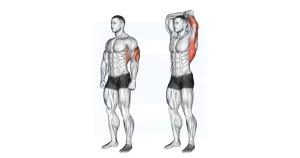
Knee to chest
Before going to bed, the Knee-to-Chest Stretch is a simple method to stretch the hips, relieve lower back stress, and encourage relaxation.
- Lay on your back on a yoga mat bed, or any other soft surface.
- Your right knee should be bent and drawn up to your chest.
- With your hands behind your thigh or your shin, gently draw your knee in.
- Keep your left leg bent for comfort or stretched on the floor.
- Hold this position for a few seconds.
- Then release your leg.
- Then return to your neutral position.
- Then relax.
- Repeat these exercises 5 to 10 times.
- Repeat with the other leg.
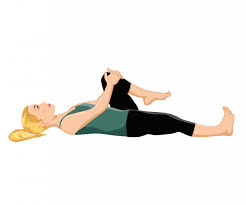
Seated forward bend
This relaxing stretch, known as the Seated Forward Bend, lengthens the lower back, hamstrings, and spine. Before going to bed, it’s ideal for reducing stress and encouraging complete relaxation.
- Your legs should be straight and extended out front of you while you sit on a comfortable surface.
- Make sure your toes point slightly upward by flexing your feet.
- Exhale deeply while extending your back.
- With a release of breath, bend at the hips and extend your hands to your feet.
- Keep your back long and loose; avoid putting too much pressure on your toes.
- Hold this position for a few seconds.
- Release slowly, then sit up again after taking a breath.
- Then return to your neutral position.
- Then relax.
- Repeat these exercises 5 to 10 times.
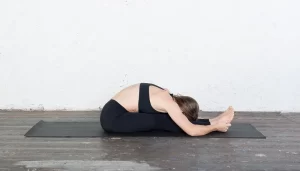
Standing Quadricep stretch
Before going to bed, the Standing Quadriceps Stretch is a great technique to increase flexibility, reduce lower body tension, and relax the front of the thighs.
- With your feet hip-width apart, take a straight posture.
- After shifting your weight to your left foot, bend your right knee such that your heel is in line with your glutes.
- Your right hand should be used to grasp your right ankle while maintaining your knees close together.
- For a deeper stretch, place your foot gently into your hand while standing tall and using your core.
- Hold this position for a few seconds.
- Release your leg slowly.
- Then return to your neutral position.
- Then relax.
- Repeat these exercises 5 to 10 times.
- Repeat with the opposite leg.
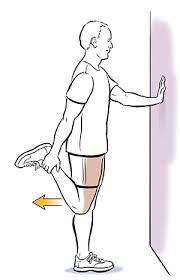
Reclining bound angle pose
An extremely healing stretch that expands the hips, decreases lower body tension and calms the nervous system, the Reclining Bound Angle Pose is ideal for winding down before bed.
- Place yourself on your back on a bed or other soft surface, such as a yoga mat.
- Letting your knees drop open to the sides, bend them, and put the soles of your feet together.
- Hold your hands palms up by your sides or place them on your stomach.
- Take a deep breath and let your hips loosen up; don’t push your knees down.
- Hold this position for a few seconds.
- Gently draw your knees together and extend your legs to relieve tension.
- Then return to your neutral position.
- Then relax.
- Repeat these exercises 5 to 10 times.
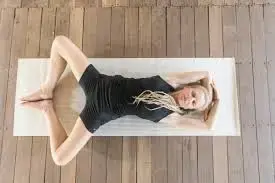
Standing calf stretch
A fantastic approach to increase circulation, ease calves’ tightness, and lessen leg cramps before bed is to perform the Standing Calf Stretch.
- With your hands shoulder-height against a wall, face the wall.
- Keep your right foot straight and put the heel firmly on the ground as you take a step back.
- Maintain a straight back leg and a tall spine while bending your left knee slightly.
- As you gradually lean forward, feel your right calf stretch deeply.
- Hold this position for a few seconds.
- Then return to your neutral position.
- Then relax.
- Repeat these exercises 5 to 10 times.
- Repeat with the left leg.
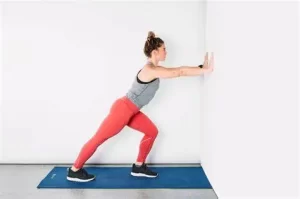
Butterfly Pose
The Butterfly Pose is a straightforward but powerful stretch that eases lower back strain, opens the hips, and encourages relaxation. It’s ideal for calming down before bed.
- Maintain a straight back while sitting on a cushioned surface.
- Your knees should drop outward as you put the soles of your feet together.
- Using your hands, grasp your ankles or feet.
- Exhale while you gently (without forcing) press your knees toward the floor, and inhale to lengthen your spine.
- Hold this position for a few seconds.
- Keep your back straight and lean forward a little for a deeper stretch.
- Stretch your legs out and release them gradually.
- Then return to your neutral position.
- Then relax.
- Repeat these exercises 5 to 10 times.

Standing hamstring stretch
Before going to bed, the Standing Hamstring Stretch is a fantastic method to release tension in the hips, lower back, and back of the legs.
- Face a stable surface, such as a bed, table, or countertop.
- With your leg straight and your toes pointed upward, plant your right foot on the ground.
- Maintain a straight left leg and a straight back.
- Lean slightly forward while maintaining a straight spine by bending at the hips as you exhale.
- Hold this position for a few seconds.
- Lower your right leg, and release slowly.
- Then return to your neutral position.
- Then relax.
- Repeat these exercises 5 to 10 times.
- Repeat with your other leg.
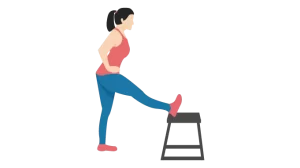
Frog stretch
A great deep stretch for expanding the inner thighs, groin, and hips is the Frog Stretch. It is ideal for relaxing before bed because it increases flexibility and relieves tension.
- Begin on all fours (hands and knees) on a bed or other soft surface.
- Maintaining your shins in alignment with your knees (your feet should point outward), gradually spread your knees apart as much as feels comfortable.
- For added support, lay your chest on a pillow or lower yourself onto your forearms.
- Keep your hips in alignment with your knees and your back upright.
- Hold this position for a few seconds.
- The stretch can be released by gently pulling your knees back together.
- Then return to your neutral position.
- Then relax.
- Repeat these exercises 5 to 10 times.
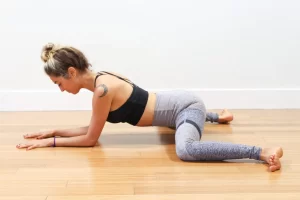
Legs-up-the-wall pose
Perfect for settling down before bed, the Legs-Up-the-Wall Pose is a very beneficial pose that reduces leg tiredness, promotes relaxation, and calms the nervous system.
- Place your hip against the wall or bed while seated sideways.
- Lean back and raise your legs so they rest against the wall.
- Make sure that your hips are comfortable near the wall, or a few inches away for a less intense pose.
- Place your palms up and keep your arms at your sides.
- Take a deep breath, close your eyes, and hold it for a few seconds.
- Bend your knees, roll sideways, and slowly sit up to release.
- Then return to your neutral position.
- Then relax.
- Repeat these exercises 5 to 10 times.
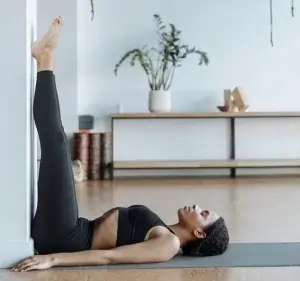
90/90 stretch
The 90/90 Stretch is a great hip-opening exercise that decreases lower back, glute, and hip strain and increases flexibility. It’s ideal for relaxing before bed.
- Your right leg should be bent at a 90-degree angle in front of you as you sit on a comfortable surface.
- With your left leg bent at a 90-degree angle, place it behind you.
- Make sure your front shin has been leveled off and that your body is upright.
- Hold here if the stretch is deep enough. Hinge forward over your front leg for increased force.
- Hold this position for a few seconds.
- Then return to your neutral position.
- Then relax.
- Repeat these exercises 5 to 10 times.
- Repeat with the other leg.
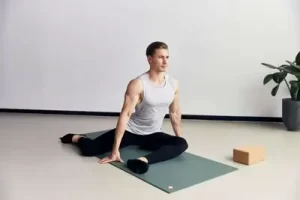
Child’s Pose
Perfect for settling down before bed, the Child’s Pose is a soothing, restorative stretch that calms the nervous system and relaxes the shoulders, hips, and spine.
- With your knees wide apart and your big toes touching, begin on all fours.
- Back toward your heels, sit with your hips.
- With your forehead lying on the bed or mat, extend your arms forward.
- Breathe deeply and let your shoulders drop, letting your body become gentler.
- Hold this position for a few seconds.
- Walk your hands back slowly and sit down again to release.
- Then return to your neutral position.
- Then relax.
- Repeat these exercises 5 to 10 times.
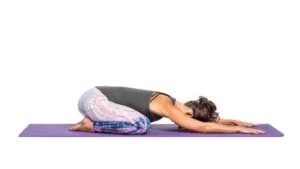
Cat cow pose
Perfect for relaxing before bed, the Cat-Cow Pose is a soft and flowing pose that helps reduce spinal tension, increase flexibility, and encourage relaxation.
- Place knees under hips and wrists beneath shoulders to begin on all fours.
- Cow Pose involves taking a breath, lowering your belly toward the mat, raising your chest, and looking slightly up.
- In Cat Pose, exhale as you draw your tummy in, tuck your chin into your chest, and straighten your back.
- Breathe in time with each movement as you progressively transition between Cat and Cow.
- Then return to your neutral position.
- Then relax.
- Repeat these exercises 5 to 10 times.
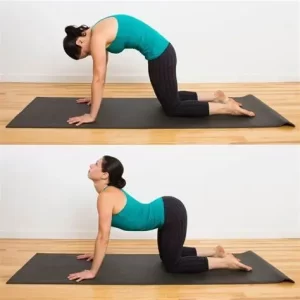
Kneeling lat stretch
An excellent addition to a stretch regimen before bed, the Kneeling Lat Stretch is a great technique to relieve tension in the lats, shoulders, and upper back.
- With your knees hip-width apart, begin by kneeling.
- Place both arms out in front of you and rest your hands on a low surface, like a bed, chair, or bench.
- With your arms outstretched, slowly lower your body down toward the floor while maintaining your hips above your knees.
- Breathe deeply and place your head comfortably between your arms.
- Return to an upright kneeling position after releasing gradually.
- Then return to your neutral position.
- Then relax.
- Repeat these exercises 5 to 10 times.
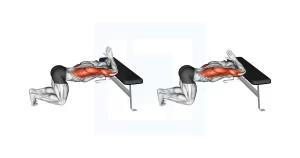
Supine hamstring stretch
Before bed, do the supine hamstring stretch to relieve stress in your lower back and legs. It might help you relax and increase your flexibility.
- Select a comfortable surface, such as a bed or yoga mat, and extend your legs while lying down.
- Straighten your leg toward the ceiling after bending and pulling your right knee to your chest.
- Wrap your foot in a towel or yoga strap if you require additional support.
- Maintain a relaxed and extended left leg on the ground.
- Hold this position for a few seconds.
- Then lower your right leg.
- Then return to your neutral position.
- Then relax.
- Repeat these exercises 5 to 10 times.
- Repeat with the other leg.
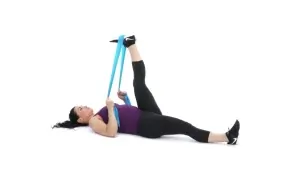
Bear hug
A quick and easy technique to relieve stress in the shoulders, upper back, and chest is the Bear Hug Stretch. To relieve tense muscles and encourage relaxation, it might be especially helpful right before bed.
- Maintain a comfortable posture with a straight back while standing or sitting.
- As if you were going to hug someone, take a deep breath and spread your arms wide.
- Taking a deep breath, cross your arms over your chest and place your left hand on your right shoulder and your right hand on your left shoulder (a self-hug).
- Feel a stretch in your upper back as you gently move your shoulders forward.
- Hold this position for a few seconds.
- Then return to your neutral position.
- Then relax.
- Repeat these exercises 5 to 10 times.
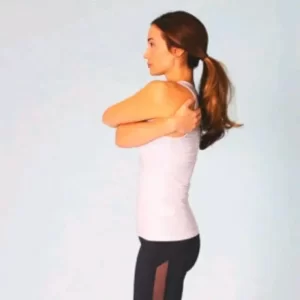
Savasana
The incredibly calming yoga pose known as Savasana (Corpse Pose) is a great way to wrap out a stretching session at night. It reduces stress, relaxes the neurological system, and gets the body ready for restful sleep.
- Lean on your back with your arms at your sides, palms up.
- Maintain a hip-width distance between your legs as they naturally fall open.
- Close your eyes and inhale deeply and slowly.
- Release any tension you may still have by actively scanning your entire body from head to toe.
- Pay attention to your breathing and let it relax and settle down.
- Try a guided body scan or repeating a calming mantra if your mind is spinning.
- Spend at least five to ten minutes in Savasana, or more if you’d like.
- When you’re ready, awaken the body by lightly moving your fingers and toes.
- Breathe a few times while rolling to one side in a fetal position.
- Then return to your neutral position.
- Then relax.
- Sit up gradually, then get into bed for a good night’s sleep.
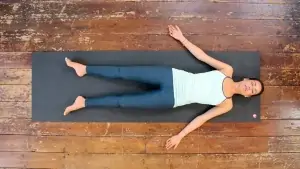
Which security precautions must be taken into account when working out?
It’s essential to take certain safety measures when performing stretching exercises before bed to prevent injuries and guarantee a routine that is both secure and effective. The following are important safety precautions:
Select a Safe Area
- Ensure that you have sufficient space to move around.
- Clear away any obstructions that can lead to a slip or fall.
- If you’re stretching on a smooth floor, use a non-slip mat.
Warm Up Calmly
- Although stretching is a low-intensity exercise, it is nonetheless advisable to warm up a little before performing deep stretches.
- Your muscles can be warmed up with simple exercises like shoulder rolls, neck tilts, or a few minutes of light walking.
Stretch Equally on Both Sides
- Stretch your body equally on both sides to avoid muscular imbalances.
Keep Your Form Correct
- Avoid hunching and maintain a neutral spine.
- For stability, use your core muscles.
- To improve flexibility and relaxation, take deep, even breaths.
Don’t Overstretch
- Keep your muscles within their natural range at all times.
- Don’t strain yourself too much; just stretch to a slight tension.
- Without swinging, hold each stretch for a few seconds.
Pay Attention to Current Injuries
- Proceed with caution and adjust stretches as necessary if you have a history of back, joint, or muscular issues.
- If deep or high-intensity stretches hurt, stay away from them.
- For individualized guidance, think about speaking with a physical therapist.
Keep Yourself Hydrated
- Maintaining sufficient water intake even before bed helps avoid cramping in the muscles.
Pay Attention to Your Body
- Don’t continue if a stretch seems uncomfortable or out of place.
- Adjust stretches to your degree of flexibility and comfort.
Do Not Hurry
- In between stretches, move slowly and cautiously.
- Stay away from sudden motions that can cause muscle strain.
Keep Up a Calm Routine
- Your muscles should relax and your body should be ready for sleep if you stretch before bed.
- For even more calming effects, combine stretching with meditation or deep breathing.
When did you stop working out?
- If You Experience Acute Pain: Stretching should never cause acute pain; instead, it should feel like a gentle tug. Quit right away if it hurts.
- After Holding for 15–30 Seconds: For most stretches to be effective, they must be kept for at least 15–30 seconds.
- Feeling Relaxed: You can quit or switch to a different stretch if the first one becomes easy and your muscles relax.
- If you start to feel exhausted or lightheaded, Overstretching can occasionally cause pain rather than relaxation, especially right before bed.
- If you have stretched all of your major muscle groups, try to stretch your neck, shoulders, back, and legs for a full-body workout.
- After five to ten minutes: A 5- to 10-minute stretching session before bed is usually enough to promote calm.
Summary:
It’s helpful for many individuals to incorporate stretching exercises into their nightly routine. In addition to promoting physical health, it helps in creating a calm and relaxed mental state that promotes restful sleep.
Stretching for five to ten minutes before bed can help you feel more relaxed, less tense, and sleep better. Stretching is a great nightly exercise to incorporate, whether your goal is to reduce stress, increase flexibility, or simply relax before bed.
Experiment with different stretches, pay attention to your body and find the most comfortable routine. If you have any health concerns at the moment, it is best to consult a healthcare professional before starting a new exercise program.
FAQ:
Is stretching before bed a good idea?
Indeed! Stretching before bed can help you sleep better by reducing stress in your muscles, increasing your flexibility, and encouraging relaxation.
How much time should I spend stretching before bed?
Gentle, static stretches should be the main focus of a 5- to 10-minute stretching regimen before bed.
Which stretches are good to perform right before bed?
Stretches that work well before bed include Child’s Pose, which eases hip and back strain.
Stretching the hamstrings and lower back can be assisted by the seated forward bend.
Stretching your neck helps release tension from the day.
The cat-cow stretch helps to relax the spine.
Hips can be opened up with the help of the butterfly stretch.
Can you get better sleep by stretching before bed?
Indeed! Sleeping is made easier by stretching because it relaxes the nervous system, lowers stress, and encourages relaxation.
Can muscle soreness be alleviated by stretching before bed?
Indeed, stretching gently can ease the pain of tense muscles by increasing circulation and decreasing muscle stiffness.
Is stretching every night safe?
Indeed! As long as you stretch gently and avoid pushing yourself to the limit, it’s fine to do so every day.
What should I not do before bed when stretching?
Avoid jerking and jumping.
Avoid going overboard to the point of pain.
Take your time; hold each stretch for 15 to 30 seconds.
Can back pain be alleviated by stretching before bed?
Indeed! Before bed, stretches like the Knee-to-Chest Stretch, Cat-Cow Stretch, and Child’s Pose can help ease stiffness and back pain.
Can I perform yoga before bed instead of stretching?
Of course! Before bed, a little yoga practice that incorporates deep breathing and gradual movements helps improve flexibility and relaxation.
Can stretches before bed help in the relief of insomnia?
Stretches before bed may help if you suffer from insomnia. Stretching gently before bed can help release tense muscles and prepare your mind for sleep, especially if your inability to fall asleep is caused by physical pain or an overactive mind.
Before going to bed, are there some stretches I should avoid?
Stretching before bed can be helpful, but stay away from intense or highly stimulating stretches that can raise your heart rate and give you more energy. In your evening stretching exercise, concentrate on soft, calming motions that encourage calmness and relaxation. It is advisable to do high-intensity exercises or stretches early in the day.
Why does it feel good to stretch before bed?
As it stimulates your parasympathetic nervous system and improves blood flow to your muscles, stretching often makes you feel wonderful. Stretching is also believed to release endorphins, which improve mood and lessen feeling uncomfortable.
References:
- Zwarensteyn, J. January 12, 2024. Sleep Advisor. https://www.sleepadvisor.org/stretching-before-bed/ 8 Stretches for Your Best Night’s Sleep
- On December 8, 2023, Pacheco, D., and Pacheco, D. Before going to bed, stretch. Foundation for Sleep. Stretching before bed: https://www.sleepfoundation.org/sleep-hygiene
- Mona, B. October 15, 2024. Try these 11 stretches before bed to help you get a better night’s sleep. Greatist. Before bed, stretch: https://greatist.com/fitness/stretching
- Cronkleton, E. February 5, 2021b. Do these eight stretches before bed. Healthline. Stretching before bed: https://www.healthline.com/health/
- Relaxed Editorial Staff. May 8, 2024. Calm Blog offers seven stretches to help you unwind and get a better night’s sleep. Calm Blog. This link will take you to a blog post about bedtime stretches.
- Three easy stretches to improve your quality of sleep. November 17, 2023. AzureWebsites.net/blogs/3-simple-stretches-to-help-you-sleep-better https://web-ih-sc-prd-hdl-wus
- Huizen, J. (July 28, 2020). Try these ten stretches before bed. Stretching before bed: https://www.medicalnewstoday.com/articles
- Smith, J. (March 24, 2022). Before going to bed, perform ten stretches. Sleep.com. Stretching before bed: https://www.sleep.com/sleep-health
- Stretches to Relax Before Bed. (n.d.). Nike.com. https://www.nike.com/a/stretches-to-wind-down-before-bed
- Image 1, Exercises for Patients | Achieve Brain & Spine (n.d.). Patient exercises can be found at https://www.achievebrainandspine.com/resources/
- Image 3, Lift by hand. 24 April 2023. Form, advantages, and instructions for the overhead arm stretch. /overhead-triceps-stretch/ Liftmanual.com
- Image 13, Hanrahan, J. (February 9, 2024). Get rid of tight hips by learning the 90/90 stretch. Hanrahan, Jack. Learn the 90-90 stretch to get rid of tight hips: https://jackhanrahanfitness.com/
- Image 16, Lift Manual. April 24, 2023f. Guidelines, advantages, and form for the Kneeling Lat Stretch on Bench. Kneeling-lat-stretch-on-bench: https://liftmanual.com/
